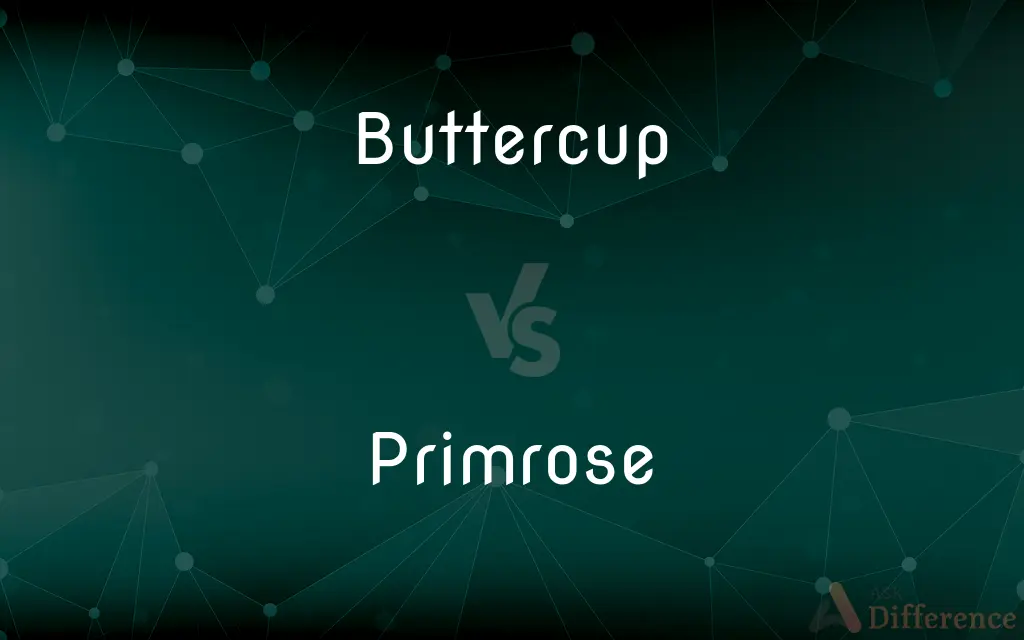Buttercup vs. Primrose — What's the Difference?
By Maham Liaqat & Fiza Rafique — Updated on March 29, 2024
Buttercups are bright yellow flowers known for their glossy petals, thriving in wet habitats, whereas primroses display a variety of colors and are early spring bloomers, favoring shaded areas.

Difference Between Buttercup and Primrose
Table of Contents
ADVERTISEMENT
Key Differences
Buttercups, belonging to the genus Ranunculus, are recognized for their vibrant yellow color and glossy petals, which have a unique property of reflecting light. These flowers typically grow in moist environments and have a simple yet striking appearance. On the other hand, primroses, part of the Primula family, boast a broader color palette, including pinks, purples, and yellows, and are known for their early spring bloom. Primroses prefer shaded or partially shaded areas, making them ideal for woodland gardens or as understory plants.
While buttercups often symbolize cheerfulness and childishness, due to their bright and sunny appearance, primroses are associated with young love and eternal existence, partially because they are among the first flowers to bloom in spring, signaling the end of winter. This difference in symbolism adds another layer of distinction beyond their physical attributes and preferred habitats.
Buttercups usually have a simple flower structure with five petals and produce a shiny appearance, which is due to the structure of their petal surfaces reflecting light in a unique way. This feature is particularly noticeable on sunny days. In contrast, primroses have a more complex appearance, with flowers that can be single or double and often feature a contrasting eye in the center of the petals, which adds depth and variety to their appearance.
In terms of cultivation, buttercups are relatively easy to grow in wet, open fields and are often found in the wild across various climates. However, some species can be invasive in certain environments. Primroses, while also not particularly demanding, require more specific conditions, such as well-drained soil rich in organic matter and shaded locations to thrive, which can make them slightly more challenging for gardeners seeking low-maintenance plants.
Both plants have their uses and appeals in different gardening and cultural contexts. Buttercups, with their simple charm and bright color, are often used to add splashes of yellow to meadows and wildflower gardens. Primroses, with their variety and early bloom, are popular in garden borders, woodland settings, and as heralds of spring in temperate climates.
ADVERTISEMENT
Comparison Chart
Family
Ranunculaceae
Primulaceae
Color Variety
Primarily yellow
Includes pinks, purples, yellows, etc.
Habitat
Moist, open fields
Shaded or partially shaded areas
Bloom Season
Late spring to early summer
Early spring
Symbolism
Cheerfulness, childishness
Young love, renewal
Petal Texture
Glossy and reflective
Varied, often with a central eye
Care Level
Easy, can be invasive
Moderate, requires specific conditions
Use in Gardens
Wildflower meadows, informal settings
Borders, woodland gardens, spring gardens
Compare with Definitions
Buttercup
A bright yellow, glossy-petaled flower common in moist areas.
The field was dotted with buttercups, shimmering under the sun.
Primrose
Part of the Primula family, symbolizing renewal.
The primrose is often seen as a symbol of new beginnings.
Buttercup
Known for its simple yet striking appearance.
Even the simplest buttercup can add beauty to a natural landscape.
Primrose
A colorful, early spring flower, often found in shaded areas.
Primroses added a splash of color to the early spring garden.
Buttercup
A member of the Ranunculaceae family.
Buttercups, like their Ranunculaceae relatives, thrive in wet conditions.
Primrose
Comes in a variety of colors with a contrasting eye.
The purple primroses with their yellow eyes were particularly striking.
Buttercup
Reflects light uniquely due to petal structure.
Buttercup petals seem to glow from within because of their light-reflecting qualities.
Primrose
Popular in garden borders and woodland settings.
She planted primroses along the shady path, brightening the walkway.
Buttercup
Symbol of cheerfulness in folklore.
She picked a buttercup, hoping its brightness would lift her spirits.
Primrose
Requires well-drained soil and partial shade.
Primroses thrive in the cool, shaded part of the garden, where the soil is rich and moist.
Buttercup
Any of numerous herbs of the genus Ranunculus, native chiefly to temperate and cold regions and having acrid juice, often toothed or lobed leaves, and usually yellow or white flowers with numerous pistils.
Primrose
Any of numerous plants of the genus Primula, having large basal leaves and clusters of variously colored flowers with a five-lobed bell-shaped or salverform corolla. Also called primula.
Buttercup
Any of many herbs, of the genus Ranunculus, having yellow flowers; the crowfoot.
Primrose
A flowering plant of the genus Primula.
Buttercup
Any flower of the genus Narcissus; a daffodil.
Primrose
Specifically, the species Primula acaulis (syn. Primula vulgaris), also called common primrose.
Buttercup
Affectionate or ironic term of address.
Primrose
A plant of the family Primulaceae.
Buttercup
A plant of the genus Ranunculus, or crowfoot, particularly Ranunculus bulbosus, with bright yellow flowers; - called also butterflower, golden cup, and kingcup. It is the cuckoobud of Shakespeare.
Primrose
A plant of the genus Oenothera, better known as an evening primrose.
Buttercup
Any of various plants of the genus Ranunculus
Primrose
A flower of a primrose plant.
Primrose
A light yellow colour.
Primrose
Of a light yellow colour.
Primrose
(intransitive) To pick primroses.
We went primrosing on Sunday and returned with a full basket.
Primrose
An early flowering plant of the genus Primula (Primula vulgaris) closely allied to the cowslip. There are several varieties, as the white-, the red-, the yellow-flowered, etc. Formerly called also primerole, primerolles.
Primrose
Of or pertaining to the primrose; of the color of a primrose; - hence, flowery; gay.
Primrose
Any of numerous short-stemmed plants of the genus Primula having tufted basal leaves and showy flowers clustered in umbels or heads
Common Curiosities
Can buttercups and primroses grow together?
While they have different habitat preferences, with proper garden planning, buttercups and primroses can be part of the same garden, offering varied textures and colors.
Are buttercups or primroses easier to grow?
Buttercups are generally easier to grow due to their adaptability to various moist conditions, whereas primroses require more specific care, such as well-drained soil and shade.
Can primroses be grown indoors?
Yes, primroses can be grown indoors with adequate care, including proper lighting and moisture control.
What does a buttercup symbolize?
A buttercup symbolizes cheerfulness and childish delight, often associated with its bright and sunny appearance.
Do buttercups need full sun?
Buttercups thrive in full sun to partial shade, but they prefer moist conditions.
Are buttercups toxic?
Yes, many species of buttercups are toxic to livestock and humans if ingested, due to the compound ranunculin.
What distinguishes a buttercup from a primrose?
Buttercups are known for their glossy yellow petals and preference for moist habitats, while primroses come in various colors and bloom early in spring, favoring shaded areas.
What does a primrose symbolize?
Primroses symbolize young love and renewal, being among the first flowers to bloom in spring, signaling the end of winter.
What soil conditions do buttercups prefer?
Buttercups prefer moist, well-drained soil but can adapt to a range of soil types.
How long do buttercups bloom?
Buttercups typically bloom from late spring to early summer, depending on the species and climate.
Do primroses prefer sun or shade?
Primroses prefer partial to full shade, making them ideal for shaded garden spots or woodland gardens.
How long do primroses bloom?
Primroses bloom in early spring, with some varieties continuing to flower intermittently throughout the summer.
What soil conditions do primroses prefer?
Primroses do best in rich, well-drained soil that retains moisture, with a preference for slightly acidic to neutral pH levels.
Can buttercups be used in floral arrangements?
While buttercups are beautiful, their sap can be irritating, so they are less commonly used in cut floral arrangements.
Share Your Discovery

Previous Comparison
Antispasmodic vs. Antispastic
Next Comparison
Sited vs. SeatedAuthor Spotlight
Written by
Maham LiaqatCo-written by
Fiza RafiqueFiza Rafique is a skilled content writer at AskDifference.com, where she meticulously refines and enhances written pieces. Drawing from her vast editorial expertise, Fiza ensures clarity, accuracy, and precision in every article. Passionate about language, she continually seeks to elevate the quality of content for readers worldwide.
















































